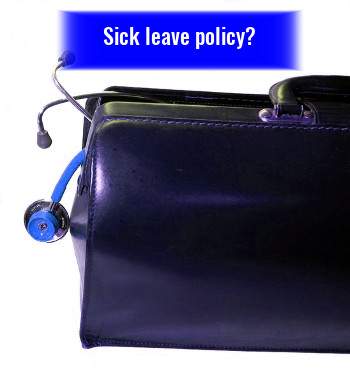The Employment Rights Advice Blog
 Articles, news and updates on employment law in Ireland
Articles, news and updates on employment law in Ireland
for employees and employers
____________________________________________________________________________________________________________________________________________________________________________________________________________________________________________________________________________________________________________________________________________________________________________________________________________________________________________________________
Sick leave in Ireland
One of the terms of employment which must be provided to an employee within two months of commencing employment relates to sick leave. This is set out in the Terms of Employment (Information) Act 1994. Your terms of employment must clearly set out the conditions which apply when an employee is incapable of working due to sickness or injury.
What should a sick leave policy contain?
As a minimum a sick leave absence management policy should contain the following:
-
Whether you offer a sick payment scheme.
-
Information on the notification and certification requirements.
-
That you as an employer can request the employee to attend a doctor nominated by you in order to be medically assessed.
Let's look at each of these in turn.
A sick pay scheme.
In the past there was no obligation on an employer under Irish employment legislation to pay an employee who was on sick leave. It was at the discretion of the employer whether to make a payment to an employee on sick leave or not. If an employee was receiving payment from the employer while on sick leave there was a requirement to sign over any illness benefit received for the duration of receipt of sick payment from the employer. This has changed since January 2023 under new legislation.
See New Statutory Sick Pay Scheme here
What about Illness benefit?
If an employee has the required social insurance contributions they may apply for Illness benefit. If they do not have the required amount of social insurance contributions they should contact the local representative of Department of Social Protection at their local health centre for an assessment regarding eligibility.
What about medical certificates ?
How soon do you want to be notified ? Ideally you require to be notified as soon as possible before the employee is due to commence work. This is to allow you make alternative working arrangements. The sick employee should notify their manager, or whoever is next in the management chain. Notification details should include, the fact that you are unfit for work and the anticipated return date.
A medical certificate is usually required on the third working day. You can select whatever date suits you.
Decide on the frequency of the certificates. They are usually required weekly, or monthly in the case of long term illness.
Define clearly short term absence, long term absence and unauthorised absence. Unauthorised absence is covered in your disciplinary procedure.
What about protracted long term absences?
When the absence continues beyond a set period, (say 3 months for example) you should review matters and examine the probability of a return to work .
In this context you should call in the employee for a discussion on their future employability. You must let them know that their ability to carry out their work is being reviewed and that this will affect employment.
Ask the employee for suggestions on what you can do as an employer, to facilitate an early return to work.
Before you make any decision to terminate the employee's contract of employment you must follow fair procedures and allow the worker an opportunity to have their side heard.
A medical examination will be an invaluable asset in your decision making.
Remember your conditions of employment should contain a requirement to attend a doctor of your choice for the purpose of being medically examined.
Returning to work
When an employee informs you that they are returning to work after a long term absence, you should request a “fit to resume doctor's note”.
If you can, you should try to facilitate a partial return to work when required by the employee.
You should interview any employee who has been of work on sick leave, regardless of the length of absence. You will find that it can deter the worker who wants to “pull a sickie” when they have to sit with you or their manager and explain their sudden recovery.
Contact us for more help
If you would like help and guidance in the area of sick pay and employee absence in Ireland, please get in touch using the orange Tell Me More button below.
Spread the knowledge. If you found this article useful, please like and share using any of the social buttons below.
Settlement agreements
When is a signed agreement not an agreement?
Settlement agreements can be an effective way to avoid a costly law suit. They are used a lot in Ireland to compromise a legal action.The standard agreement usually provides for the payment of a sum of money by the employer, in return for the employee undertaking not to proceed with a legal claim. So how can a signed agreement, where the requisite money has changed hands be overturned by the courts?
The main basis for the courts to uphold a settlement agreement is that the employee must give “full and informed consent” This was considered in the case of Sunday World Newspapers Limited v Kinsella and Bradley (2007). In that case the courts outlined what should be reflected in a proper settlement agreement.
The more recent case of Eoin Kerrigan v Smurfit Kappa Limited c/o Smurfit Kappa UD1921/2011, outlinews the importance of both sides obtaining independent expert advice. The employee succeeded in obtaining an award of €10,000.00 , in spite of the fact the he had already received from his employer,payment of €25,280.00 in full and final settlement of all claims arising from his employment with that employer. The employment appeals tribunal held that as he had not been advised in writing to seek appropriate advice before signing the waiver, the employee could bring a case under the Unfair Dismissals legislation and awarded him €10,000.00.
A further case of Healy v Irish Life Assurance (DEC-E2015-002) held that where all of the steps have been followed in a settlement agreement, it can withstand scrutiny. The settlement agreement was not overturned and the employee failed in his action.
The conditions generally required for the agreement to be enforceable are that:
-
the agreement is in writing and signed by the employee,
-
the claims being waived and discharged are clearly set out; and
-
the employee has taken independent expert advice.
- the employee has had a reasonable period of time to consider the full consequences of their action in signing the settlement agreement. A number of days minimum is recommended.
- It can be helpful if the employer offers to make a contribution towards the cost of the employee's independent expert advice.
- All signatures should be witnessed.
Is there a precedent I can use to draft a settlement agreement?
We recommend that you talk to one of our experts when preparinga settlement agreement.
However if you want to do it yourself you can download our updated settlement agreement, which comes with our simple guide to completing it . You can opt to have the completed document reviewed by one of our experts for peace of mind. Just click on the green button below, to help reduce your legal expenses.
In the light of this all employers should proceed with caution when settling a case. Take care, take advice and make sure that the employee does so too.
For more detailed information and to discuss any aspect of employment law, please contact us using the orange Tell Me More button below.
Spread the knowledge. If you found this article useful, please like and share using any of the social buttons below.
Set up and manage remote workers, home workers and lone workers
Time to do your homework
If some of your employees work from home or another venue remotely then there are a number of matters to consider. Similarly the employee who works on their own on your premises.
There's no place like home
That is a true saying, and in the context of health and safety in the workplace, it poses it's own challenges. The same rules on health and safety apply in the home as in the office/ business premises. Is the workstation suitable? Is it at the right height, properly lit, correct ergonomics and more ? Are there any hazards ? You should examine the home workplace as rigorously as you would the business premises.
Is there proper insurance in place? Employer's liability, Employee's liability, Public liability.
Does the contract of employment cover home working? If not then you will have to change it. If the changes do not apply to all employees, then you may have unhappy workers.
If your contract of employment does not mention home working then you should use a working from home policy. This is a standard policy document which deals with the various aspects of home working.
You can download a Covid-19 updated working from home policy template using the button below.
How do you organise training for home workers? Who pays for the fit out/ up keep of the part of the home used for home working?
Communications and motivation will play an important role in the success of the home working endeavours. A secure IT environment is essential to protect business data.
What aspects of the Safety, Health and Welfare at Work Act should I consider ?
You must consider the duty of care which you have towards your employees when they are working from home. This applies to their workspace at home, in the same way as it does to their workspace in your business premises. The duties can be summarised as follows:
- Arranging and conducting all work activities so as to ensure, as far as reasonably practicable, the safety, health and welfare of the worker
- Plan, maintain and provide a safe system of work
- Carry out risk assessment and put the recommendations in place.
- Provide safe equipment. This includes personal protective equipment if the assessment calls for it.
- Training,information, instruction and supervision must be provided to the employee regarding health and safety
- Prepare and implement an emergency plan
What equipment must I provide for my employees to facilitate working from home?
Assuming that you have made the decision that working from home is feasible for the employee, then you must supply the equipment which they need to carry out their work. For, example, computer, calculator, printer(if needed) etc. Consider potential data breach, where the employee offers to use their own computer.
What are the challenges involving the use of computers and IT equipment at home ?
The Covid-19 crisis has created a situation where employers and employees are forced to consider working at home arrangements at short notice, and initially on a temporary basis. It is important therefore that both the employer and employee consider the following matters, all of which have been applicable in the business workplace, and which must be applied to the home workplace now:
- Avoid staying in the same position for too long while working. Vary your tasks to incorporate a change in physical position.
- Minimise twisting or overreaching due to the position of the equipment.
- Avoid screen glare
- Look away from the screen regularily
- Take regular breaks. Move at least one minute in every hour
- Is the home workspace big enough to hold all of the equipment?
- Do you have adequate Data Protection measures in place.
Keeping in contact with the employees
- Make sure that you have up to date contact details for each worker, including updated emergency contact details.
- Ensure that each worker has the relevant emergency contact details for the business, should they need to contact you urgently
- Set up a routine of regular updates and keeping in touch in a planned way
- How good is your IT support for each employee working from home?
- Organise work so as to encourage the use of breaks
- Respect the start time and end time of the working day. Both employer and employee. It is easy to lose sight of when work ends and home life begins.
- Establish a method of keeping track of the time worked by the home worker, so as to comply with Working time legislation. This is ultimately your responsibility as an employer.
What are my employees responsibilities, when working from home ?
Legislation places an obligation on the employee to :
- Protect themselves from harm as well as others. If any equipment is faulty or poses a danger to them or fellow workers, they have a duty to report it to you.
- All of the laws applicable to working in you business premises apply to the home workplace also, therefore an employee has a duty to report any injury to you, immediately.
- Every employee has a duty to follow your reasonable instructions, including policies and procedures.
- Every employee has a duty not to breach GDPR . They must take effective steps to ensure the privacy of data.
How can I ensure that my employees are aware of their GDPR obligations, when working from home ?
Keeping data private is important at all times. It is important to be aware of the risks of data breach when working from home. We offer an online course to help employees understand the risk of data breach when working from home. The course makes employees aware of the danger areas and how to avoid them. It is mainly focussed on the remote worker, but is applicable to the workplace environment also.
The course involves providing the knowledge in an interesting way and testing that knowledge by completing quizzes and questionaires to enable the participant progress through the course. There is a certificate of completion at the end, when the person taking the course has completed all of the quizzes and questionnaires successfully. The certificate issues in the name of the participant. This proves that they have completed the course successfully. This is useful from an employer's point of view, especially from a vicarious liability point of view. It shows that you have provided training for the employee and that they know the rules and obligations of general data protection regulation (GDPR).
Are there any tax reliefs available to the employee who works from home?
The Revenue Commissioners have put together a document on e-Working and Tax. You can download it using the link below. It explains the position of home expenses and how they are dealt with as well as other matters. It usefully, defines e-working.
Is there a checklist I can use?
The Department of Enterprise, Trade and Employment has produced a useful checklist for employers and employees who are getting to grips with all that is involved in working remotely.
You can download it here
For more on the Right to Disconnect see
Download HSA document Position yourself well here
Download HSA DSE simple assessment form here
Download Revenue e-Working and Tax document here
Watch and download a slideshare presentation here
Watch our YouTube video
What about the lone worker?
As well as all of the requirements applicable to the average employee, the lone worker may face an increased security risk. Especially if they are handling cash, or other valuable items.
Make sure that you have a policy in place to deal with working hours, data protection and emergencies. The lone worker should be familiar with this policy.
Ensure that all remote work places are safe and secure.
Regularly review the safety of your remote employees. Ask them if they feel safe and what you can do to improve safety.
If your employee works in someone else's home or business premises, you still have a responsibility to ensure that they are working in a safe environment.
Where can I get more advice?
For advice you can trust on this and all employment law matters in Ireland please get in touch using the orange Yes! Tell Me More button below.
Spread the knowledge. If you found this article useful, please like and share using any of the social buttons below.
The probationary period
Some truths and some myths
It is always advisable to have a probationary period when starting a new employee's career with your business.
It gives you both time to make sure that you have made the right decision.
In order to avail of a probationary period you must include it in the employee's contract of employment and the individual must be aware that their job depends on the obligation to successfully complete same.
Be careful when drafting the letter offering the job to the employee. Make sure that it refers to a probationary period. Only include what is essential in the letter.
In order to keep within the exemptions as laid down in the Unfair Dismissals Act 1997 – 2007, the probationary period (including holiday entitlements and the employee's notice period) must not exceed twelve months.
I can sack the employee with ease during the probationary period. Myth!
A decision of the Labour Court in January 2011 has debunked the myth that you can sack an employee on a whim if they are on a probationary period. It held that the employer should have followed either it's own disciplinary procedures or those outlined in the Code of Practice on Grievance and Disciplinary Procedures S.I. No 146 of 2000, when dismissing an employee on probation. (Irish Postmasters Union – and- A Worker ) The court in that instance recommended €30,000 in compensation. That case was taken under the Industrial Relations Acts 1946 to 1990. Recommendations issued which relate to the Industrial Relations Act 1969 (Section 13) are not enforceable.
This highlights the need for expert advice when considering the dismissal of a worker.
Industrial Relations Act, 1990 (Code of Practice on Grievance and Disciplinary Procedures) (Declaration) Order, 2000, Download here
What should I add to a contract of employment to deal with this?
You should develop procedures for dismissing a worker while on a probationary period. Then you should incorporate them in the standard contract of employment which you offer to new employees.
If you fail to do this, then your existing dismissal procedures must be followed, when dismissing a worker on probation.
The Probationary policy should set out how issues of performance, conduct or suitability for the role will be dealt with.
The employment contract should state that the probationary Policy will be implemented in respect of all workers on probation, and not the Disciplinary Policy.
Remember that in dealing with grievances and disciplinary matters you should always follow the rules of Natural Justice.
The employee should sign the contract. As part of employee induction the new worker should be briefed on all of the procedures referred to in the contract of employment, and should sign an attendance sheet for the briefing. The use of an employee handbook is a very useful way to communicate the rules and regulations of the business. This should be included in the briefing and an acknowledgement form should be signed by the employee confirming receipt of the handbook and agreeing to be bound by the company's policies.
How can I extend the probationary period?
You can extend the period if there is provision to do so in the contract of employment or staff handbook. The maximum normal period is six months, subject to an exception under which it may be extended up to twelve months. For more see
Hold probationary review meeting at set points in the probation period. Give feedback to the employee. The final probationary review should assess the employee's performance and suitability.
You will either confirm the appointment, dismiss the employee or extend the probationary period.
If dismissal is to be considered, you must hold a disciplinary hearing and only make the decision after hearing all sides. You must give the reasons for dismissal in writing to the employee.
If a decision to extend the period is made then this should be communicated to the employee in writing, giving the reasons why and the expected improvements and the review schedule.
Is there a DIY solution to drafting a contract of employment with a probationary policy ?
Yes. We advise you to get help from our experts. However if you want to do it yourself you can download our updated employment contract document, together with our simple guide to completing it . You can opt to have the completed document reviewed by one of our experts for peace of mind. Just click on the green button to view our selection of employment law documents to help reduce your legal expenses.
What action can an employee take, who has been unfairly dismissed during a probationary period?
An employee who has been unfairly dismissed during a probationary period can pursue a claim under any of the following:
-
A claim under the Industrial Relations Act 1969 (as amended)
-
A Civil Court action for breach of contract/ wrongful dismissals
-
A claim under the Equality Acts 1998 – 2004 , where one of the grounds apply.
- A claim under the Unfair Dismissals Acts where the probationary period has extended past twelve months.
Where can I get help and advice on employment law in Ireland?
Just use the orange Tell Me More button below. and one of our experts will contact you at a time that suits.
Spread the knowledge. If you found this article useful, please like and share using any of the social buttons below.
Latest Employee Blogs
- Performance Improvement Plan or Exit Strategy?
- Whistleblower awarded five years salary by Workplace Relations Commission
- Unlawful COVID-19 pay cut
- Unfair Redundancy Case
- How to raise a problem at work
- Trade Secrets and Whistleblowing
- Is your fixed term contract valid?
- What is it like to bring an unfair dismissal claim?
- Employer relocation
- End of P45
Latest Employer Blogs
- Changes to probationary period
- Redundancy Update
- COVID-19 Vaccination Data in the workplace
- Statutory Sick Pay Scheme
- The Right to Disconnect
- Covid-19 Can I use lay off and short time to cope with Covid-19 ?
- Covid-19 (The Coronavirus) Tips for employers
- Social Media Monitoring in the Workplace
- Using 3rd party CCTV footage
- Do I need a Data Protection Officer ?
















